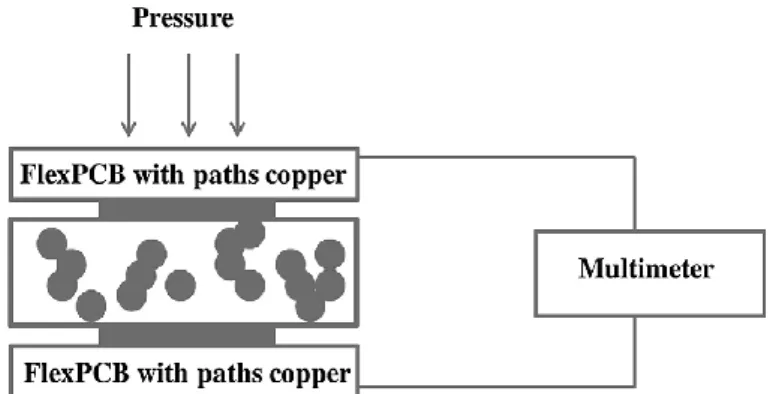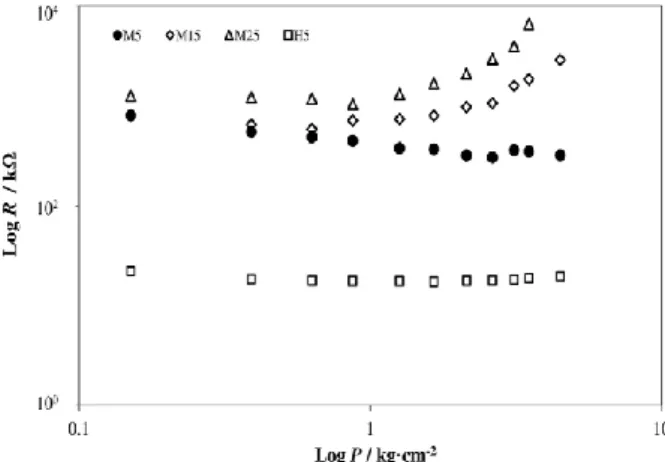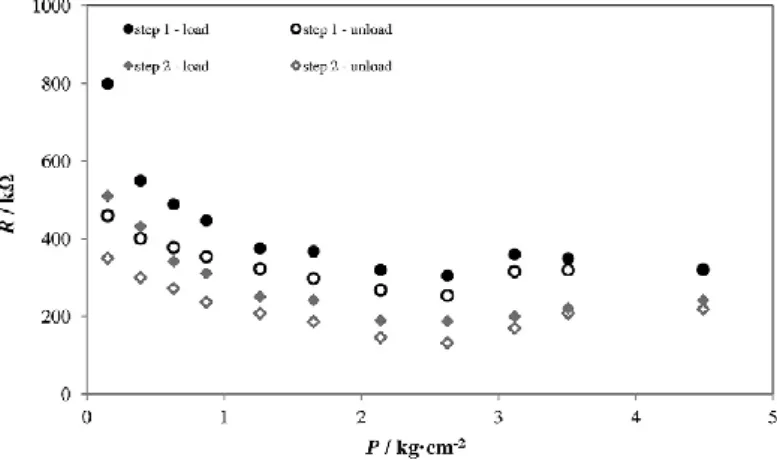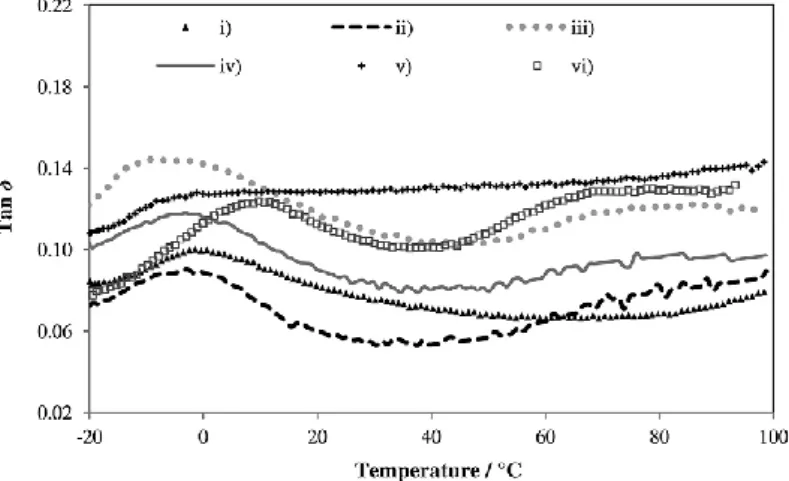This article was published in Polymer Testing, 37, 127-137, 2014
http://dx.doi.org/10.1016/j.polymertesting.2014.05.010
Development of porous polymer pressure sensors
incorporating graphene platelets
Vera Gonçalves
a, b, Lúcia Brandão
a, Adélio Mendes
a*
a
LEPABE - Faculdade de Engenharia, Universidade do Porto, rua Dr. Roberto
Frias, 4200-465 Porto, Portugal
b
Kinematix (Former Tomorrow Options Microelectronics S.A.), rua das
Oliveiras 72, 4050-448 Porto, Portugal
Abstract
Electrically conductive polymer composites (ECPCs) based on porous polymeric matrices of PEBA 4033 incorporating different types of graphene platelets were prepared and tested. PEBA 4033 polymer was mixed with different graphene platelets: grade H5, grade MX and grade C-750. Porous morphology was obtained for the ECPCs prepared with graphene platelets grade MX and H5, while for the grade C-750 only a dense ECPCs was obtained. The porous ECPC loaded with 15 vol.% of graphene M5 exhibited a linear piezoresistive response in a log-log plot. Some limitations were detected for this ECPC, namely hysteresis and drift due to the poor mechanical properties. The porous ECPC loaded with 15 vol.% M5 was further crosslinked, which improved its mechanical properties but the piezoresistive effect became negligible. The incorporation of carbon black in this ECPC formulation was shown to be much more efficient than crosslinking to improve mechanical properties, but the piezoresistive response became poor.
1. Introduction
In recent years, there has been an increasing interest in the use of carbon based materials in many applications as sensors and composites materials [1e2]. The discovery of graphene, the elementary structure of graphite, made a revolutionary change in scientific and technological applications and has earned Kostya S. Novoselov and Andre K. Geim the Physics Nobel Prize in 2010. Graphene is a single
layer of sp2 bonded carbon atoms patterned in a hexagonal lattice that has unique
properties such as high electrical conductivity and mechanical strength that can be used in electrically conductive polymer composites (ECPCs) [2-4]. Graphene is classified by the number of stacked layers: single layer, few-layer (2-10 layers) and multi-layer (thin graphite); the number of layers needed for the properties of graphene to fully match those of bulk graphite is over 100 [4]. Recently, some studies reported the preparation of polymer-graphene/expanded graphite composites [3,5-9]. Some authors studied different methods of preparation of the polymer matrix incorporating graphene platelets and their effects on the mechanical and electrical properties. They concluded that the graphene dispersion influences the electrical response of ECPCs [3,5-10]. Chandrasekaran et al. [3], for example, employed two mixing methods, three-roll milling and sonication combined with high speed shear mixing, and they concluded that the three-roll milling method improved electrical conductivity 5 orders of magnitude at 0.3 wt.%. On the other hand, polymer composites incorporating graphene platelets showed a low percolation threshold [3,9] and promote an improvement in the mechanical properties that increases the storage modulus (E') and stiffness of the material [3,7-8,10]. However, the diameter of graphene platelets influences mechanical properties. Kalaitzidou et al. [7], for example, fabricated polypropylene containing exfoliated graphite platelets, xGnP, (graphene sheets 10 nm thickness) by melt mixing and injection molding. The addition of xGnP - 1 (~1 m diameter) promotes greater improvement in the mechanical properties than adding carbon black. However, the addition of xGnP - 15 (~15 m diameter) led to poor mechanical properties due to the difficulty of dispersing it, and resulted in a non-homogeneous composite.
The present work targets for the first time the development and characterization of porous ECPCs prepared loaded with graphene platelets of different geometries (length, surface area and thickness). The piezoresistive response and mechanical properties were also evaluated.
2. Experimental
2.1. Materials
PEBAX polymer (polyether block amide) was supplied by Atofina Chemicals. Ethanol, hexane, 2, 4 - toluyene dii-socyanate (TDI), n-methyl-2-pyrrolidone (NMP) and acetone were purchased from Sigma Aldrich. Distilled water was also used as non-solvent. Carbon black powder (Vulcan® XC72R) was purchased from Cabot Corporation. Graphene platelets (GNP) grade C-750, M5, M15, M25 and H5, were purchased from XG Sciences. These materials have following characteristics: M type-maximum length of 5 m, 15 m and 25 m, respectively M5, M15 and M25, average
thickness of 6-8 nm and surface area between 120 m2 g-1 and 150 m2 g-1;
H5-maximum length 5 m, average thickness of 15 nm and surface area between 50 m2
g-1 and 80 m2 g-1 and C-750 maximum length 1-2 m, average thickness of 2 nm and
average surface area of 750 m2 g-1.
2.2. Preparation of porous ECPCs by immersion precipitation method based
on PEBA 4033
Different weight fractions of GNPs were dispersed in NMP by sonication for 15 minutes. Polyether block amide (PEBA) 4033 was dissolved in NMP to form a polymer solution that was added to a previously prepared NMP suspension of conductive particles. When the polymer solution became homogeneous, it was poured onto a glass plate. ECPCs were prepared by the immersion precipitation method. Briefly, the film was then exposed to room temperature before immersion in the non-solvent at room temperature. After that, the film was washed under running water and then kept overnight in a water bath. Finally, the film left to dry at room temperature for 2 days [11-12].
Fig. 1 shows the PEBA 4033 films obtained after using the immersion precipitation method. The initially cast PEBA 4033 films changed their colour from a transparent liquid film to a white porous film (high light dispersion originated from the occlusion of air bubbles) after immer-sion in the non-solvent. Shrinkage of the film was also observed that caused it to be easily separated from the glass plate after 5 minutes (left image). With incorporation of graphene, the change of colour due to the build-up of the pores was not easily detected by visual inspection. How-ever, it was observed that PEBA 4033 formulations containing graphene changed their colour from dark grey (cast film) to a lighter grey with build-up of pores (right image).
Fig. 1. PEBA 4033 films obtained after the immersion precipitation method (left
image: porous plain PEBA 4033 film, right image: porous PEBA 4033 film incorporating graphene platelets).
Table 1 lists the PEBA 4033 films prepared by the immersion precipitation method with different types of graphene platelets.
Table 1. Porous ECPs based on PEBA 4033 incorporating graphene
2.3. Crosslinking of porous ECPCs based on PEBA 4033
ECPC based on PEBA 4033 loaded with graphene platelets was immersed in a 2 % (v/v) solution of TDI in hexane for 30 minutes. The ECPC was removed from the bath and washed with distilled water for an hour. Finally, the ECPC was dried in an oven at 60 �C followed by vacuum drying for 24 hours [13].
2.4. Scanning electron microscopy analysis (SEM)
The cross-section morphologies of ECPCs based on PEBA 4033 were observed by scanning electron microscopy (SEM) using a JEOL JSM-6301F, Oxford INCA Energy 350 instrument. Samples were fractured in liquid nitrogen and sputtered with gold/platinum using a K575X Sputter Coater by Quorum Technologies.
2.5. Measurement of electrical resistance
The electrical resistance of the prepared ECPCs based on PEBA 4033 was measured using a multimeter (Fluke 11) in an in-house made mechanical press. The effective area of the electrode was 1 cm2. The electrical contact between the ECPC film and
the multimeter was obtained using a copper layer applied over a polymeric film (FlexPCB). Two layers of a polymeric film with similar composition to the ECPCS but having electric conductivity two orders of magnitude higher were applied on each side of the ECPC film to be characterized (Fig. 2). The elevated electrical conductivity of the electrode was obtained by adding a higher concentration of conductive particles (usually 25 vol.% of carbon black(CB)).
Fig. 2. Experimental set-up for measuring of the electrical resistance of the ECPCs.
2.6. Dynamic mechanical analysis (DMA)
DMA experiments were performed using a DMA 242 E from Netzsch in film compression mode at a frequency of 1 Hz and 10 Hz. Nitrogen gas was used at a flow rate of 80 ml/min. Samples were tested at temperatures ranging from -20 oC to 100 oC with a heating rate of 2 oC/min.
3. Results and discussion
3.1. Incorporation of graphene platelets in PEBA 4033 ECPCs with different
combinations of solvent/non-solvent pairs
Some combinations of non-solvent/solvent (NMP) were tested in order to achieve the best procedure for obtaining porous ECPCs based on PEBA 4033 and incorporating M5 graphene platelets. Fig. 3 shows the effect of the non-solvent on the morphology of PEBA 4033 incorporating 5.5 vol.% of M5. When using water, the ECPC obtained is dense due to the hydrophilic nature of the non-solvent. On the
other hand, the hexane/acetone mixture (95 wt.%/5 wt.%) and ethanol were the most promising non-solvent for preparing ECPCs based on graphene conductive particles. We found that the porous morphology was observed even after increasing graphene concentration to 15 vol.%, see below (Fig. 5).
Fig. 3. Cross-section SEM images of the PEBA 4033 film (a) and the ECPCs (b-d) with
5.5 vol.% M5 at different magnifications and different solvents: film (a) - non-solvent: water, film (b) - non-non-solvent: water, film (c) - non-non-solvent: ethanol and film (d) - non-solvent: hexane/acetone.
7
3.2. Incorporation of different types of graphene platelets in ECPCs
The different types of graphene were employed to pre-pare ECPCs based on PEBA 4033 and using hexane/acetone as non-solvent. As mentioned before, with incorporation of 5.5 vol.% M5, the ECPCs obtained were porous. Increasing graphene M5 concentration to 15 vol.%, the ECPC morphology kept it porosity (Figs. 4 and 5). A porous morphology was also observed for graphene types M15, M25 and H5 at a concentration of 15 vol.%, (Figs. 4 and 5). On the other hand, the ECPCs incorporating 15 vol.% of graphene C-750 showed a dense morphology (Fig. 4d).
It should be stressed that the morphology of the films obtained with graphene type H and type M (Figs. 4 and 5)is quite interesting, showing a regular cellular structure with a large range of interconnecting pores. This type of porous polymeric composite film can be used in applications such as thermal and mechanical insulators, packaging materials, drug carrier systems, medical devices and solid supports for catalysis [14], and for biosensors, chemical gas sensors, electronic devices and smart fabrics [15-18].
Fig. 6 shows a higher magnification (20 000 x) of the platelets that seem to be embedded in the polymeric matrix.
Fig. 4. Cross-section SEM images of the ECPCs (films d and e) incorporating 15 vol.% of
8 Fig. 5. Cross-section SEM images of the ECPCs (films f-h) incorporating 15 vol.% of graphene
MX: film (f) - M5, film (g) - M15 and film (h) - M25.
Fig. 6. Cross-section in high magnification of ECPCs (film e and f) incorporating 15 vol.% of
9
3.3. Piezoresistive response in the porous ECPCs based on PEBA 4033 loaded with
graphene platelets
The piezoresistive behaviour of the prepared porous ECPCs incorporating graphene platelets was evaluated. The electrical resistance of ECPCs incorporating 5.5 vol.% of graphene M5 was too high.
Fig. 7 shows the electrical resistance as a function of the applied pressure for ECPCs loaded with 15 vol.% graphene MX and H5. The H5-ECPC exhibited the lowest electrical resistance of all the ECPCs tested, while the others ECPCs showed similar electrical resistances. Moreover, H5-ECPC did not show any pressure sensitivity. On the other hand, the most promising piezoresistive response was obtained with the ECPC loaded with graphene M5, which exhibited an approximately linear response on a log-log plot. It can also be observed that the electrical resistance changes from 810 k to 340 k (approximately) from no pressure applied to ca. 2.5 kg cm-2, Fig. 8. From approximately 2.5 kg cm-2 to 4.5 kg cm-2, M5-ECPC does not show pressure
sensitivity, while M15-ECPC and M25-ECPCs did not stand pressures above of 0.6 kg cm-2
(suffered mechanical damage). At pressures higher than 0.6 kg cm-2, the destruction of the
conductive paths is higher than their formation and this decrease of conductive pathways number increases electrical resistance [19-21].
Fig. 7. Electrical resistance (log-log plot) as a function of the applied pres-sure of ECPCs based
on PEBA 4033 loaded with 15 vol.% of graphene (type M5, M15, M25 and H5) assembled with polymeric electrodes.
3.4. Hysteresis and drift of M5-ECPC
Since the most promising piezoresistive response observed was the M5-ECPC, hysteresis and drift were also assessed. Fig. 8 shows the electrical response as a function of the applied pressure for two load and two unload steps obtained for the M5-ECPC assembled with polymeric electrodes. The sample responded steadily after 5 s under load and 10 s after unload. During the first step, the electrical resistance changed from 810 k to 340 k and after the first unload step, the electrical resistance changed from 340 k to 460 k, indicating significant hysteresis. In the second load step, begun 30 s after the end of first unload step and after 5 s under load, the electrical resistance changed from 510 k to 180 k, and after 10 s of the second unload steps, the electrical resistance change 180 k to 350 k, again showing hysteresis. The poor mechanical properties of M5-ECPC could be responsible for the electrical hysteresis and drift [15]. The hysteresis of M5-ECPC is related to the plastic deformation occurring during the load
10
step, and this irreversible phenomenon is related to the ECPC high load of graphene particles [22].
Fig. 8. Electrical resistance as a function of the applied pressure (load and unload steps) of
ECPC based on PEBA 4033 loaded with 15 vol.% of graphene M5 assembled with polymeric electrodes.
3.5. Dynamic mechanical properties
The mechanical properties were evaluated by dynamic mechanical analysis (DMA). The storage modulus (E') and phase angle () of the prepared ECPC/graphene polymer films and pure dense and porous PEBA 4033 polymer films from -20 oC to 100oC are shown in Fig. 9 and Fig. 10,
respectively. The storage modulus represents the elastic component of a material and is an indicator of the capability of a material to store energy reversibly. Pure dense PEBA 4033 film exhibits an E' higher than porous PEBA 4033 film, 149 MPa versus 13.45 MPa at 25 oC. On the
other hand, porous M5-ECPC (incorporating 15 vol.% of graphene M5) showed an E' 22.9% higher compared to the pure porous PEBA 4033 film (13.45 MPa versus 16.53 MPa at 25 oC). The
same behavior was observed by Tang et al. [10] who concluded that the storage modulus increased when introducing graphene (1.2 nm thick) in a polymeric film. However, with introduction of the larger graphene platelets (graphene M15), the storage modulus decreased 30.3 %compared with the pure porous PEBA 4033 film (10.32 MPa versus 16.53 MPa at 25 oC).
The good dispersion of graphene M5 in PEBA 4033, also related to the small size of the graphene M5 platelets (ca. 5 m length and 6-8 nm thick), could be the reason why the composite film display better mechanical properties [3,7-8,10]. In the case of porous M15-ECPC, it was more difficult to disperse the graphene particles.
To further improve the mechanical properties, ECPCs were either crosslinked or carbon black was added to the PEBA 4033 polymer matrix. The crosslinked M5-ECPC showed a storage modulus of 22.0 MPa at 25 oC while the M5/carbon black-ECPC showed a storage modulus of
51.0 MPa (an increase 63.6% versus an increase of 379%, compared with the pure porous PEBA 4033 film).
Tan is the ratio between the amount of energy dissipated by viscous mechanisms and the energy stored in the elastic component, providing information about the viscoelastic properties of the material [8]. The maximum tan d as a function of temperature is related to the glass-transition temperature (Tg). Table 2 shows the glass-glass-transition temperature of the prepared polymers films. In the case of crosslinked porous M5-ECPC, the peak of tan was not clear,
11
indicating that the glass-transition temperature was obtained at a lower temperature (maximum tan was shifted to left) or the crosslinking reduced the mobility of polymer chains and decreased the height of the tan d peak [3]. On the other hand, the introduction of car-bon black on porous M5-ECPC raised the glass-transition temperature ca. 10 oC.
Fig. 9. E' (log scale) as a function of temperature for: i) pure dense PEBA 4033 film, ii) pure
porous PEBA 4033 film, iii) porous M5-ECPC (incorporating 15 vol.% of M5), iv) porous M15-ECPC (incorporating 15 vol.% of M15), v) crosslinked porous M5-M15-ECPC (incorporating 15 vol.% of M5) and vi) porous M5/carbon black-ECPC (incorporating 8 vol.% of M5 and 2 vol.% of carbon black).
Fig. 10. Tan d as a function of temperature for: i) pure dense PEBA 4033 film, ii) pure porous
PEBA 4033 film, iii) porous M5-ECPC (incorporating 15 vol.% of M5), iv) porous M15-ECPC (incorporating 15 vol.% of M15), v) crosslinked porous M5-ECPC (incorporating 15 vol.% of M5) and vi) porous M5/carbon black ECPC (incorporating 8 vol.% of M5 and 2 vol.% of carbon black).
12 Fig. 11. Electrical resistance (log-log plot) as a function of the applied pressure of unmodified
and crosslinked M5-ECPC assembled with polymeric electrodes.
3.6. Crosslinking of the porous M5-ECPC
Porous M5-ECPC was crosslinked in order to reduce the hysteresis and drift by increasing mechanical properties. The crosslinked M5-ECPC assembled with the polymeric electrodes exhibited a higher electrical resistance when compared to the M5-ECPC without crosslinking (Fig. 11). In fact, there is a systematic increase in electrical resistance when the sample is crosslinked. Indeed, after crosslinking none of the ECPCs based on PEBA 4033 loaded with graphene M5 (loads of 15 vol.% and 18 vol.%) showed a piezoresistive response.
3.7. Introduction of carbon black in porous M5-ECPCs
Fig. 12 shows the electrical resistance of M5-ECPC and a M5/carbon black-ECPC as a function of the applied pressure. With introducing 2 vol.% of carbon black, the electrical resistance and porosity decreased. Fig. 13 shows SEM images of M5/carbon black-ECPC film where a decrease of the porosity can be seen. A higher porosity seems to be related to a smaller electrical conductivity and, to keep the electrical conductivity within the required bounds, the introduction of carbon black should be followed by decrease of graphene loading. However, the best piezoresistive response was obtained for the ECPC incorporating 15 vol.%of graphene M5 and without carbon black, despite the potential improvement of the mechanical properties that this additive could bring.
13
Fig. 12. Electrical resistance (log-log plot) as a function of the applied pressure of M5/carbon black-ECPCs assembled with polymeric electrodes.
Fig. 13. Cross-section SEM images of M5/carbon black-ECPC.
4. Conclusions
Porous ECPCs based on PEBA 4033 and incorporating different types of graphene (C, M and H) platelets were prepared. The immersion precipitation method allowed the preparation of porous composite films with a nodule structure and symmetric morphology when a mixture of hexane/acetone was used as the non-solvent. ECPCs based on PEBA 4033 loaded with 15 vol.% of graphene M5 exhibited a piezoresistive response more linear on a log-log plot than the other prepared ECPCs. Porous M5-ECPC (incorporating 15 vol.% of graphene M5) showed, however, some hysteresis and drift due to poor mechanical properties. Crosslinked PEBA 4033 and the incorporation of carbon black were considered to improve the mechanical properties but significantly worse piezoresistive responses were observed.
Acknowledgments
V. Gonçalves is grateful to the Portuguese Foundation for Science and Technology (FCT) and Kinematix (former Tomorrow Options) for her PhD Grant (reference: SFRH/BDE/33880/2009). The authors are thankful to Professor Fernão Magalhães, Professor Sérgio Cunha and Eng. João Neiva for the helpful discussions and CEMUP for the SEM analysis.
14
References
[1] A.M. Pinto, I.C. Gonçalves, F.D. Magalhães, Graphene-based materials biocompatibility: a review, Colloids and Surfaces B: Bio-interfaces 111 (1 November 2013) 188e202.
[2] M. Batzill, The surface science of graphene: metal interfaces, CVD synthesis, nanoribbons, chemical modifications, and defects, Surface Science Reports 67 (3e4) (2012) 83e115.
[3] S. Chandrasekaran, C. Seidel, K. Schulte, Preparation and characterization of graphite nanoplatelet (GNP)/epoxy nano-composite: mechanical, electrical and thermal properties, European Polymer Journal 49 (12) (December 2013) 3878e3888.
[4] M.S. Artiles, C.S. Rout, T.S. Fisher, Graphene-based hybrid materials and devices for biosensing, Advanced Drug Delivery Reviews 63 (14e15) (2011) 1352e1360.
[5] A.M. Pinto, J. Martins, J.A. Moreira, A.M. Mendes, F.D. Magalhães, Dispersion of graphene nanoplatelets in poly(vinyl acetate) latex and effect on adhesive bond strength, Polymer International 62 (6)(2013) 928e935.
[6] A. Yasmin, J.-J. Luo, I.M. Daniel, Processing of expanded graphite reinforced polymer nanocomposites, Composites Science and Technology 66 (9) (2006) 1182e1189.
[7] K. Kalaitzidou, H. Fukushima, L.T. Drzal, Mechanical properties and morphological characterization of exfoliated graph-iteepolypropylene nanocomposites, Composites Part A: Applied Science and Manufacturing 38 (7) (2007) 1675e1682.
[8] W. Zheng, S.-C. Wong, Electrical conductivity and dielectric properties of PMMA/expanded graphite composites, Composites Science and Technology 63 (2) (2003) 225e235.
[9] J. Liang, Y. Wang, Y. Huang, Y. Ma, Z. Liu, J. Cai, C. Zhang, H. Gao, Y. Chen, Electromagnetic interference shielding of graphene/epoxy composites, Carbon 47 (3) (2009) 922e925.
[10] Z. Tang, H. Kang, Q. Wei, B. Guo, L. Zhang, D. Jia, Incorporation of graphene into polyester/carbon nanofibers composites for better multi-stimuli responsive shape memory performances, Carbon 64 (November 2013) 487e498.
[11] B. Chakrabarty, A.K. Ghoshal, M.K. Purkait, Effect of molecular weight of PEG on membrane morphology and transport properties, Journal of Membrane Science 309 (1e2) (2008) 209e221.
[12] J.C. Jansen, M.G. Buonomenna, A. Figoli, E. Drioli, Ultra-thin asymmetric gas separation membranes of modified PEEK prepared by the dryewet phase inversion technique, Desalination 193 (1e3) (2006) 58e65.
[13] S. Sridhar, R. Suryamurali, B. Smitha, T.M. Aminabhavi, Development of crosslinked poly(ether-block-amide) membrane for CO2/CH4 separation, Colloids and Surfaces A: Physicochemical and Engi-neering Aspects 297 (1e3) (2007) 267e274.
[14] H.P. Hentze, M. Antonietti, Porous polymers and resins for biotechnological and biomedical applications, Reviews in Molecular Biotechnology 90 (1) (2002) 27e53.
[15] S. Brady, D. Diamond, K.-T. Lau, Inherently conducting polymer modified polyurethane smart foam for pressure sensing, Sensors and Actuators A: Physical 119 (2) (2005) 398e404.
15
[16] S. Ravati, B.D. Favis, 3D porous polymeric conductive material pre-pared using LbL deposition, Polymer 52 (3) (2011) 718e731
[17] M. Li, W. Zhang, C. Wang, H. Wang, In situ formation of 2D conductive porous material with ultra low percolation threshold, Materials Letters 82 (1 September 2012) 109e111. [18] E. Danesh, S.R. Ghaffarian, P. Molla-Abbasi, Non-solvent induced phase separation as a method for making high-performance chemiresistors based on conductive polymer nanocomposites, Sensors and Actuators B: Chemical 155 (2) (2011) 562e567.
[19] W. Luheng, D. Tianhuai, W. Peng, Influence of carbon black con-centration on piezoresistivity for carbon-black-filled silicone rubber composite, Carbon 47 (14) (2009) 3151e3157.
[20] J. Lu, X. Chen, W. Lu, G. Chen, The piezoresistive behaviors of polyethylene/foliated graphite nanocomposites, European Polymer Journal 42 (5) (2006) 1015e1021.
[21] K.K. Sadasivuni, D. Ponnamma, S. Thomas, Y. Grohens, Evolution from graphite to graphene elastomer composites, Progress in Polymer Science 39 (4) (April 2014) 749e780. [22] G. Barra. Parte 1: Fundamentos de Reologia de Materiais Poliméricos. [cited 2012 may]; Available from: http://emc5744. barra.prof.ufsc.br/Reologia%20parte%201.pdf.









